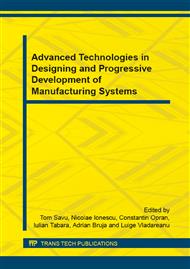[1]
L.J. Gibson, M.F. Ashby, Cellular Solids, Structure and Properties, second ed., Cambridge University Press, Cambridge, (1997).
Google Scholar
[2]
N.J. Mills, Polymer Foams Handbook: Engineering and Biomechanics Applications and Design Guide, Elsevier , Oxford, (2007).
Google Scholar
[3]
L. Marsavina, Fracture Mechanics of Cellular Solids, in: H. Altenbach, A. Ochsner (Eds. ), Cellular and porous materials in structures and processes, Springer, Wien, 2010, pp.1-46.
DOI: 10.1007/978-3-7091-0297-8_1
Google Scholar
[4]
C.W. Fowlkes, Fracture toughness of a rigid polyurethane foam, Int. J. Fract. 10 (1974) 99-108.
DOI: 10.1007/bf00955084
Google Scholar
[5]
G.M. Viana, L.A. Carlsson, Mechanical properties and fracture characterisation of cross-linked PVC foams, J. Sandw. Struct. Mater. 4 (2002) 99-113.
Google Scholar
[6]
M. Burman, Fatigue crack initiation and propagation in sandwich structures, Report No. 98-29, Stockholm (1998).
Google Scholar
[7]
M.E. Kabir, M.C. Saha, S. Jeelani, Tensile and fracture behavior of polymer foams, Mat. Sci. Eng. A429 (2006) 225-235.
Google Scholar
[8]
S. Choi, B.V. Sankar, Fracture toughness of carbon foam, J. Compos. Mater. 37 (2003) 2101-2116.
Google Scholar
[9]
N.A. Fleck, O.B. Olurin, C. Chen, M.F. Ashby, The effect of hole size upon the strength of metallic and polymeric foams, J. Mech. Physics Solids 49 (2001) 2015 – (2030).
DOI: 10.1016/s0022-5096(01)00033-3
Google Scholar
[10]
O.B. Olurin, N.A. Fleck, M.F. Ashby, Deformation and fracture of aluminium foams, Mat. Sci. Eng. A291 (2000) 136-146.
DOI: 10.1016/s0921-5093(00)00954-0
Google Scholar
[11]
McIntyre, G.E. Anderton, Fracture properties of a rigid PUR foam over a range of densities, Polymer 20 (1979) 247-253.
DOI: 10.1016/0032-3861(79)90229-5
Google Scholar
[12]
M. Danielsson, Toughened rigid foam core material for use in sandwich construction, Cell. Polym. 15 (1996) 417-435.
Google Scholar
[13]
ASTM D5045-99: Standard Test Methods for Plane-Strain Fracture Toughness and Strain Energy Release Rate of Plastic Materials.
DOI: 10.1520/d5045-99
Google Scholar
[14]
M.Y. He, J.W. Hutchinson, Asymmetric four-point crack specimen, J. Appl. Mech. 67 (2000) 207–209.
Google Scholar
[15]
M.R. Ayatollahi, M.R.M. Aliha, H. Saghafi, An improved semi-circular bend specimen for investigating mixed mode brittle fracture, Eng. Fracture Mech. 78 (2011) 110–123.
DOI: 10.1016/j.engfracmech.2010.10.001
Google Scholar
[16]
L. Marsavina, D.M. Constantinescu, E. Linul, D.A. Apostol, T. Voiconi, T. Sadowski, Refinements on fracture toughness of PUR foams, Eng. Fracture Mech. in press, http: /dx. doi. org/10. 1016/j. engfracmech. 2013. 12. 006.
DOI: 10.1016/j.engfracmech.2013.12.006
Google Scholar
[17]
A.R. Shahani, S.A. Tabatabaei, Computation of mixed mode stress intensity factors in a four-point bend specimen, Appl. Math. Modell. 32 (2008) 1281–1288.
DOI: 10.1016/j.apm.2007.04.001
Google Scholar


